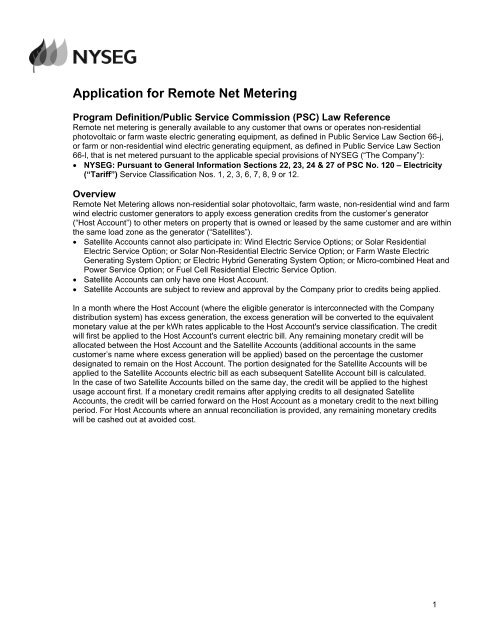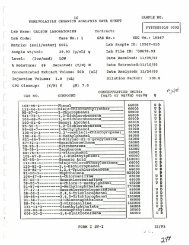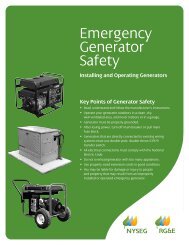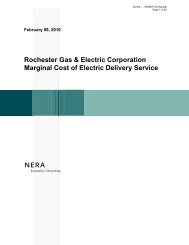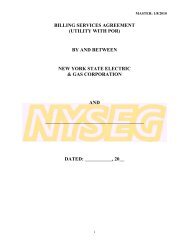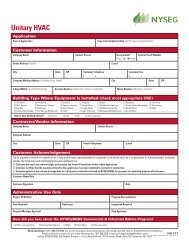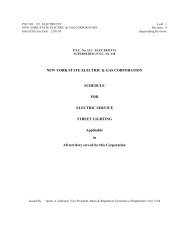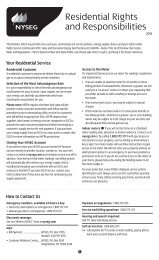Remote Net Metering Application Form - nyseg
Remote Net Metering Application Form - nyseg
Remote Net Metering Application Form - nyseg
Create successful ePaper yourself
Turn your PDF publications into a flip-book with our unique Google optimized e-Paper software.
<strong>Application</strong> for <strong>Remote</strong> <strong>Net</strong> <strong>Metering</strong><br />
Program Definition/Public Service Commission (PSC) Law Reference<br />
<strong>Remote</strong> net metering is generally available to any customer that owns or operates non-residential<br />
photovoltaic or farm waste electric generating equipment, as defined in Public Service Law Section 66-j,<br />
or farm or non-residential wind electric generating equipment, as defined in Public Service Law Section<br />
66-l, that is net metered pursuant to the applicable special provisions of NYSEG (“The Company”):<br />
• NYSEG: Pursuant to General Information Sections 22, 23, 24 & 27 of PSC No. 120 – Electricity<br />
(“Tariff”) Service Classification Nos. 1, 2, 3, 6, 7, 8, 9 or 12.<br />
Overview<br />
<strong>Remote</strong> <strong>Net</strong> <strong>Metering</strong> allows non-residential solar photovoltaic, farm waste, non-residential wind and farm<br />
wind electric customer generators to apply excess generation credits from the customer’s generator<br />
(“Host Account”) to other meters on property that is owned or leased by the same customer and are within<br />
the same load zone as the generator (“Satellites”).<br />
• Satellite Accounts cannot also participate in: Wind Electric Service Options; or Solar Residential<br />
Electric Service Option; or Solar Non-Residential Electric Service Option; or Farm Waste Electric<br />
Generating System Option; or Electric Hybrid Generating System Option; or Micro-combined Heat and<br />
Power Service Option; or Fuel Cell Residential Electric Service Option.<br />
• Satellite Accounts can only have one Host Account.<br />
• Satellite Accounts are subject to review and approval by the Company prior to credits being applied.<br />
In a month where the Host Account (where the eligible generator is interconnected with the Company<br />
distribution system) has excess generation, the excess generation will be converted to the equivalent<br />
monetary value at the per kWh rates applicable to the Host Account's service classification. The credit<br />
will first be applied to the Host Account's current electric bill. Any remaining monetary credit will be<br />
allocated between the Host Account and the Satellite Accounts (additional accounts in the same<br />
customer’s name where excess generation will be applied) based on the percentage the customer<br />
designated to remain on the Host Account. The portion designated for the Satellite Accounts will be<br />
applied to the Satellite Accounts electric bill as each subsequent Satellite Account bill is calculated.<br />
In the case of two Satellite Accounts billed on the same day, the credit will be applied to the highest<br />
usage account first. If a monetary credit remains after applying credits to all designated Satellite<br />
Accounts, the credit will be carried forward on the Host Account as a monetary credit to the next billing<br />
period. For Host Accounts where an annual reconciliation is provided, any remaining monetary credits<br />
will be cashed out at avoided cost.<br />
1
<strong>Application</strong> for <strong>Remote</strong> <strong>Net</strong> <strong>Metering</strong><br />
Billing Example<br />
Assumptions: Customer elects 10% of excess generation credit to remain at Host Account, 90% is<br />
eligible for Satellite application, totaling 100%. Two Satellites have been designated and bill at the<br />
same time. Host Service Classification = SC7-1<br />
Current billing period scenario:<br />
Host Account electric bill (i.e. customer charges, demand charge) on SC7-1 = $2,000<br />
Host Account excess kWh generation converts to monetary credit on SC7-1 = $3,000<br />
Excess credit is applied to Host Account first: $3,000 - $2,000 = $1000 remaining credit.<br />
‣ 10% remains at Host Account: $1000 x 10% = $100<br />
‣ 90% will be applied to Satellites: $1000 x 90% = $900<br />
‣ Satellite 1 Electric bill = $350; Satellite 2 Electric bill = $500<br />
(When two or more Satellites bill at the same time, credit is applied first to the Satellite with highest use)<br />
Satellite 2: $900 - $500 = $400 remaining credit; Credit is applied next to Satellite 1: $400 - $350 = $50<br />
remaining credit.<br />
Remaining credit of $50 is returned to the Host Account. $100 credit reserved + $50 remaining credit =<br />
$150 total excess credit carried forward on Host Account.<br />
2
<strong>Application</strong> for <strong>Remote</strong> <strong>Net</strong> <strong>Metering</strong><br />
<strong>Application</strong><br />
Please provide the information requested below, return only the application page.<br />
1. Host Account<br />
Customer Name<br />
(as listed on the electric account):<br />
Service Address<br />
(Street, City and ZIP):<br />
Contact Name:<br />
Phone:<br />
E-mail:<br />
Account Number (11 digits):<br />
Percentage of excess credit to<br />
remain at the host account (after<br />
host application) (0% to 99%):<br />
Example: Entering 0% means 0% of the excess credit would remain at the host account<br />
(after host application), 100% of the excess credit (after host application) would then be<br />
eligible for approved satellite accounts.<br />
2. Satellite(s)<br />
Contract Account Number (11 Digits) xxxx-xxxx-xxx<br />
This application for <strong>Remote</strong> <strong>Net</strong> <strong>Metering</strong> supplements but does not supersede any pre-existing<br />
<strong>Application</strong>s for Electric Service under the Tariff(s).<br />
Service to be supplied to the Applicant will be supplied and conditioned on the Applicant’s ongoing<br />
compliance with the terms, conditions and procedures set forth in both the Tariff(s) and the Company<br />
Specification and Requirements for Electric Installations as both may be amended from time to time.<br />
_____________________________________ (Applicant/Title)<br />
_____________________________________ (Date)<br />
3
<strong>Application</strong> for <strong>Remote</strong> <strong>Net</strong> <strong>Metering</strong><br />
<strong>Application</strong> Submission<br />
Please submit completed applications for review and processing as follows:<br />
1. For new Interconnect Customers, the <strong>Remote</strong> <strong>Net</strong> Meter application must be returned within 30 days<br />
after the interconnect date. <strong>Remote</strong> <strong>Net</strong> <strong>Metering</strong> will commence with the first full Host invoice issued<br />
after the interconnect date.<br />
E-mail: DistributedGenerationAdmin@energyeast.com<br />
Mail: NYSEG – Electric Transmission Services<br />
18 Link Drive<br />
Binghamton, NY 13904<br />
Attn: R. Kauffman / M. Chier<br />
2. For new applicants already interconnected, or existing <strong>Remote</strong> <strong>Net</strong> <strong>Metering</strong> customers who wish to<br />
make a change, the Annual Enrollment period is from January 1 through January 31 each year.<br />
Annual updates to Satellites will be effective with the initial Host Account billing after March 1 of the<br />
same enrollment year.<br />
E-mail: NYSEGBackOffice@<strong>nyseg</strong>.com<br />
Fax 1.585.340.1665<br />
Mail: P.O. Box 5240<br />
Binghamton, NY 13902-5240<br />
Attn: Back Office<br />
Questions regarding <strong>Remote</strong> <strong>Net</strong> <strong>Metering</strong> and/or the application please contact us at:<br />
E-mail: NYSEGBackOffice@<strong>nyseg</strong>.com<br />
Phone: 1.607.762.8077, you will be directed to leave a voicemail message, including a contact phone<br />
number. Someone from the appropriate group will return your call within 2 business days.<br />
4


